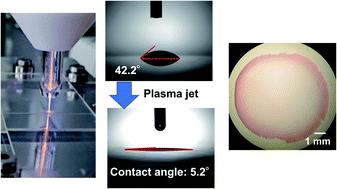当前位置:
X-MOL 学术
›
J. Anal. At. Spectrom.
›
论文详情
Our official English website, www.x-mol.net, welcomes your
feedback! (Note: you will need to create a separate account there.)
Total reflection X-ray fluorescence analysis with a glass substrate treated with a He atmospheric pressure plasma jet
Journal of Analytical Atomic Spectrometry ( IF 3.1 ) Pub Date : 2021-06-25 , DOI: 10.1039/d1ja00164g Kouichi Tsuji 1 , Tsugufumi Matsuyama 1 , Tsuneo Fukuda 2 , Soichiro Shima 3 , Mayuko Toba 3 , Jun-Seok Oh 2, 4 , Tatsuru Shirafuji 2, 4
Journal of Analytical Atomic Spectrometry ( IF 3.1 ) Pub Date : 2021-06-25 , DOI: 10.1039/d1ja00164g Kouichi Tsuji 1 , Tsugufumi Matsuyama 1 , Tsuneo Fukuda 2 , Soichiro Shima 3 , Mayuko Toba 3 , Jun-Seok Oh 2, 4 , Tatsuru Shirafuji 2, 4
Affiliation

|
Total reflection X-ray fluorescence (TXRF) is a powerful technique for trace elemental analysis of various liquid samples. A small volume of the liquid sample is dropped onto a flat substrate, and the dried residue is measured using TXRF. Usually, the substrate surface is treated with a silicone solution to make it hydrophobic. Such hydrophobic substrates are useful to concentrate the analyte at a small point, leading to a dot-type residue. However, the solution sample will provide a residue with a height of several tens of μm depending on the matrix of the solution, in which self-absorption is a serious problem. In this paper, the authors applied a He atmospheric pressure plasma jet (APPJ) treatment to a glass substrate to obtain a hydrophilic surface. The chemical properties of the glass substrate surface were drastically changed by the application of the He APPJ. The contact angle of the liquid droplet was 5.2° on the APPJ-treated glass, while it was 88.8° on the glass with a silicone layer. A droplet of the liquid solution smoothly spread over the APPJ-treated glass substrate, leading to a thin film-like residue. The recovery and detection limits for TXRF analysis of a standard solution sample were improved especially for low-Z elements by using the APPJ-treated glass substrates. This new sample preparation technique was also applied for TXRF analysis of a red wine sample. We found that this hydrophilic glass substrate gave a film-like residue from a small droplet of the red wine. Reasonable TXRF quantitative results were obtained by the Ga internal standard method. The preliminary experimental results suggested that the film-type residue produced on the APPJ-treated substrate was effective in decreasing the matrix effect especially for low-Z elements.
中文翻译:

使用 He 常压等离子体射流处理的玻璃基板进行全反射 X 射线荧光分析
全反射 X 射线荧光 (TXRF) 是一种强大的技术,可用于各种液体样品的痕量元素分析。将少量液体样品滴在平坦的基材上,然后使用 TXRF 测量干燥的残留物。通常,基材表面用有机硅溶液处理以使其疏水。这种疏水性底物可用于将分析物浓缩在一个小点上,从而产生点型残留物。然而,根据溶液的基质,溶液样品会提供高度为几十微米的残留物,其中自吸收是一个严重的问题。在本文中,作者对玻璃基板应用 He 常压等离子体射流 (APPJ) 处理以获得亲水表面。He APPJ 的应用极大地改变了玻璃基板表面的化学性质。APPJ 处理过的玻璃上液滴的接触角为 5.2°,而带有有机硅层的玻璃上的接触角为 88.8°。一滴液体溶液平稳地铺在经过 APPJ 处理的玻璃基板上,导致薄膜状残留物。通过使用经 APPJ 处理的玻璃基板,标准溶液样品的 TXRF 分析的回收率和检测限得到改善,尤其是对于低 Z 元素。这种新的样品前处理技术也适用于红葡萄酒样品的 TXRF 分析。我们发现这种亲水性玻璃基材会从一小滴红酒中产生薄膜状残留物。Ga内标法得到了合理的TXRF定量结果。
更新日期:2021-07-13
中文翻译:

使用 He 常压等离子体射流处理的玻璃基板进行全反射 X 射线荧光分析
全反射 X 射线荧光 (TXRF) 是一种强大的技术,可用于各种液体样品的痕量元素分析。将少量液体样品滴在平坦的基材上,然后使用 TXRF 测量干燥的残留物。通常,基材表面用有机硅溶液处理以使其疏水。这种疏水性底物可用于将分析物浓缩在一个小点上,从而产生点型残留物。然而,根据溶液的基质,溶液样品会提供高度为几十微米的残留物,其中自吸收是一个严重的问题。在本文中,作者对玻璃基板应用 He 常压等离子体射流 (APPJ) 处理以获得亲水表面。He APPJ 的应用极大地改变了玻璃基板表面的化学性质。APPJ 处理过的玻璃上液滴的接触角为 5.2°,而带有有机硅层的玻璃上的接触角为 88.8°。一滴液体溶液平稳地铺在经过 APPJ 处理的玻璃基板上,导致薄膜状残留物。通过使用经 APPJ 处理的玻璃基板,标准溶液样品的 TXRF 分析的回收率和检测限得到改善,尤其是对于低 Z 元素。这种新的样品前处理技术也适用于红葡萄酒样品的 TXRF 分析。我们发现这种亲水性玻璃基材会从一小滴红酒中产生薄膜状残留物。Ga内标法得到了合理的TXRF定量结果。










































 京公网安备 11010802027423号
京公网安备 11010802027423号